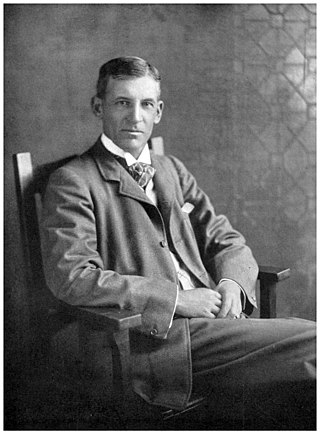A golf club is a club used to hit a golf ball in a game of golf. Each club is composed of a shaft with a grip and a club head. Woods are mainly used for long-distance fairway or tee shots; irons, the most versatile class, are used for a variety of shots; hybrids that combine design elements of woods and irons are becoming increasingly popular; putters are used mainly on the green to roll the ball into the hole. A set of clubs is limited by the rules of golf to a maximum of 14 golf clubs, and while there are traditional combinations sold at retail as matched sets, players are free to use any combination of legal clubs.
The following is a glossary of the terminology currently used in the sport of golf. Where words in a sentence are also defined elsewhere in this article, they appear in italics. Old names for clubs can be found at Obsolete golf clubs.

In the sport of golf, a wedge is a subset of the iron family of golf clubs designed for special use situations. As a class, wedges have the highest lofts, the shortest shafts, and the heaviest clubheads of the irons. These features generally aid the player in making accurate short-distance "lob" shots, to get the ball onto the green or out of a hazard or other tricky spot. In addition, wedges are designed with modified soles that aid the player in moving the clubhead through soft lies, such as sand, mud, and thick grass, to extract a ball that is embedded or even buried. Wedges come in a variety of configurations, and are generally grouped into four categories: pitching wedges, sand wedges, gap/approach wedges and lob wedges.
In golf, a gap wedge, also known as an approach wedge, is a wedge used to hit a shot with higher and shorter trajectory than a pitching wedge and lower and longer trajectory than a sand wedge. The name derives from the club's design to fill the "gap" between sand and pitching wedges.
A pitching wedge is a wedge used to hit a shot with higher and shorter trajectory than a 9-iron and a lower and longer trajectory than a gap wedge.
Karsten Solheim was an American golf club designer and businessman. He founded Karsten Manufacturing, a golf club maker better known by the name of PING, and the Solheim Cup, the premier international team competition in women's golf.

Walter J. Travis was an American amateur golfer during the early 1900s. He was also a noted golf journalist and publisher, an innovator in all aspects of golf, a teacher, and golf course architect.
The rules of golf consist of a standard set of regulations and procedures by which the sport of golf should be played. They are jointly written and administered by The R&A and the United States Golf Association (USGA). The R&A is the governing body of golf worldwide except in the United States and Mexico, which are the responsibility of the USGA. The rule book, entitled Rules of Golf, is updated and published on a regular basis and also includes rules governing amateur status.
Ping, Inc. is an American sports equipment manufacturing company based in Phoenix, Arizona. It focuses on golf equipment, producing golf clubs and golf bags. The company was founded by Karsten Solheim, following a career as an engineer at the General Electric company. In 1959, he started making putters in his garage in Redwood City, California. In 1967, he resigned from his job at General Electric to develop the PING company.
The shaft of a golf club is the long, tapered tube which connects the golfer's hands to the club head. While hundreds of different designs exist, the primary purpose of the golf shaft remains the same: to provide the player with a way to generate centrifugal force in order to effectively strike the ball. When properly gripped the player can hit the ball further and more accurately, whilst applying less force.

Golf equipment encompasses the various items that are used to play the sport of golf. Types of equipment include the golf ball, golf clubs, and devices that aid in the sport.
In the sport of golf, a penalty or penalty stroke is an additional stroke or strokes added to a player's score for an infraction of the rules. In match play, rather than adding strokes, the usual penalty is loss of the hole except for penalties assessed for relief from a hazard or a lost ball.

A wood is a type of club used in the sport of golf. Woods have longer shafts and larger, rounder heads than other club types, and are used to hit the ball longer distances than other types.

An iron is a type of club used in the sport of golf to propel the ball towards the hole. Irons typically have shorter shafts and smaller clubheads than woods, the head is made of solid iron or steel, and the head's primary feature is a large, flat, angled face, usually scored with grooves. Irons are used in a wide variety of situations, typically from the teeing ground on shorter holes, from the fairway or rough as the player approaches the green, and to extract the ball from hazards, such as bunkers or even shallow water hazards.

A hybrid is a type of club used in the sport of golf with a design borrowing from both irons and woods while differing from both. The name "hybrid" comes from genetics to denote a mixture of two different species with desirable characteristics of both, and the term here has been generalized, combining the familiar swing mechanics of an iron with the more forgiving nature and better distance of a wood.

Golf is a club-and-ball sport in which players use various clubs to hit a ball into a series of holes on a course in as few strokes as possible.

The golf swing is the action by which players hit the ball in the sport of golf. The golf swing is a complex motion involving the whole body; the technicalities of the swing are known as golf stroke mechanics.
A lob wedge, also known as a lofted wedge or an L-Wedge, is a wedge used in the sport of golf, known for being one of the shortest-hitting clubs and providing the most loft on a shot. Lob wedges are used to produce shots with a very high arc, and are most often used for shots over hazards and other obstructions. Due to the high arc of the shot the lob wedge, like the other wedges in the set of irons, produces little roll after landing on the putting green and can even be used to produce backspin if necessary. Lob wedges are one of the newest additions to the modern collection of golf clubs and, along with the sand wedge and gap wedge, were not included prior to 1931.
David T. Pelz is an American golf coach, known for his expertise and published writing on the art of the short game, particularly putting.
The Ping Gold Putter Vault provides the storage of the golf clubs from the Ping Gold Putter Program that was initiated by Karsten Solheim, to commemorate a golfer's victory using a Ping putter. Since the 1970s, tournament champions are presented with a gold-plated putter matching the specs of their putter and engraved with both their name and the name of the tournament won. A replica of the golf club is stored in a vault at the Ping headquarters in Phoenix, Arizona.










